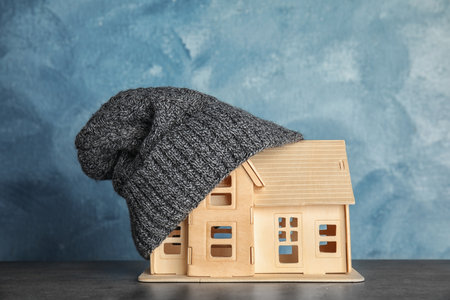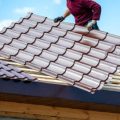Visible Roof Damage
One of the most obvious signs that your roof needs immediate attention is visible damage. Regularly inspecting your roof from the ground or using binoculars can help you catch early warning signs before they turn into costly repairs. Here are some of the most common visible indicators that something might be wrong with your roof:
Common Signs of Visible Roof Damage
| Sign | Description | Why It Matters |
|---|---|---|
| Missing Shingles | Shingles may fall off due to wind, aging, or poor installation. | Exposes the underlayment and decking to water damage. |
| Cracked or Broken Tiles | Often caused by weather changes or impact from falling debris. | Allows moisture to seep into the structure below. |
| Sagging Areas | Parts of the roof appear to dip inward. | Could indicate structural issues or water damage beneath the surface. |
| Curling or Buckling Shingles | The edges of shingles lift up or bend out of shape. | Usually a sign of aging materials or poor attic ventilation. |
| Granule Loss on Shingles | You may notice bald spots or granules in gutters and downspouts. | Reduces the shingles’ ability to protect against UV rays and water. |
What You Can Do About It
- Schedule a Professional Inspection: If you notice any of these issues, it’s best to call a licensed roofing contractor for a full assessment.
- Tarp Damaged Areas: Temporarily covering exposed sections with a waterproof tarp can prevent further water intrusion until repairs are made.
- Avoid DIY Fixes: Unless youre experienced, attempting repairs yourself could cause more harm than good—or even lead to injury.
- Document the Damage: Take photos for insurance purposes before making any temporary fixes.
When to Act Fast
If you see multiple missing shingles after a storm, notice sagging areas, or find pieces of roofing material in your yard, dont wait. These are urgent red flags that require professional attention right away to avoid interior leaks and costly structural problems down the road.
Pro Tip:
Conduct seasonal checks—especially after heavy storms or extreme temperature changes—to catch visible damage early and keep your roof in top condition year-round.
2. Leaks and Water Stains Inside the Home
If you’ve noticed mysterious water stains on your ceilings or walls, or worse, drops of water falling inside your home during a rainstorm, it’s time to take action. These signs are red flags that your roof may be compromised and in urgent need of repair.
What to Look For
Indoor water damage often starts subtly but can quickly escalate if ignored. Here are some common signs that suggest your roof might be leaking:
| Sign | What It Means |
|---|---|
| Ceiling Discoloration | Yellowish or brown stains can indicate water is seeping through the roof into your attic and ceiling drywall. |
| Peeling Paint or Bubbling Wallpaper | Moisture trapped behind walls causes paint to peel or wallpaper to bubble, signaling a persistent leak. |
| Dripping Water During Rain | This is an obvious and serious sign that your roof has an active leak needing immediate attention. |
| Mold or Mildew Smell | A musty odor indoors could mean mold growth caused by a hidden roof leak. |
Why This Is Urgent
Ignoring these warning signs can lead to structural damage, ruined insulation, and costly interior repairs. Even small leaks can develop into major issues like wood rot, electrical hazards, and mold infestations if not addressed promptly.
Immediate Steps You Should Take
- Inspect the Attic: Check for damp insulation, water trails, or dark spots on the wood framing.
- Contain Active Leaks: Use buckets or containers under drips to prevent further interior damage until repairs can be made.
- Call a Roofing Professional: A licensed roofer can assess the extent of the damage and recommend appropriate fixes.
Tip:
If youre unsure whether the stain is old or new, mark its outline with a pencil and monitor it after the next rainfall. If it expands, your roof is actively leaking and needs urgent repair.

3. Moss, Algae, or Mold Growth
Seeing moss, algae, or mold growing on your roof might not seem like a big deal at first glance, but it can actually be a sign of deeper problems. These organic growths thrive in damp, shaded areas and often mean that moisture is being trapped on your roof. Over time, this moisture can lead to damage beneath the shingles and even affect the underlying structure of your home.
Why Organic Growth Is a Red Flag
When moss or algae starts to grow, its usually because water isnt draining properly. This can happen due to clogged gutters, poor ventilation, or damaged shingles that allow water to seep in. Once the moisture gets trapped, it creates the perfect environment for mold and mildew to spread — both of which can break down roofing materials and cause wood rot.
Common Issues Caused by Moss, Algae, and Mold
| Type of Growth | Potential Problems |
|---|---|
| Moss | Lifts shingles and traps water underneath, leading to leaks and rot. |
| Algae | Stains roof surface and retains moisture, weakening shingles over time. |
| Mold | Can spread into attic spaces and compromise air quality; indicates prolonged moisture exposure. |
How to Address Organic Growth on Your Roof
1. Schedule a Professional Inspection
If you notice patches of green or black on your roof, have a roofing contractor inspect it immediately. They’ll assess whether there’s structural damage beneath the surface.
2. Clean Your Roof Safely
A professional can remove moss and algae using specialized cleaning solutions that wont harm your shingles. Avoid pressure washing — it can cause more damage than good.
3. Improve Ventilation and Drainage
Poor attic ventilation and blocked gutters are common causes of moisture retention. Make sure your attic has proper airflow and clean out your gutters regularly to keep water moving off your roof efficiently.
4. Consider Preventative Measures
You can install zinc or copper strips along the ridge of your roof. Rainwater activates these metals, creating an environment where moss and algae cant grow easily.
If left untreated, organic growth can shorten your roofs lifespan and lead to costly repairs down the line. Regular maintenance is key to keeping these issues in check.
4. Granules in Gutters and Downspouts
Finding shingle granules in your gutters or downspouts might seem like no big deal at first, but its actually a red flag that your roof could be in trouble. Asphalt shingles are coated with tiny granules that protect them from the sun’s UV rays and help with water resistance. Over time, as shingles age or get damaged by harsh weather, these granules can start to wear off.
Why Granules Matter
Granules are essential for keeping your shingles strong and effective. When you notice an unusual amount of them collecting in your gutters, it often means the shingles are deteriorating and may no longer be able to protect your home from leaks or further damage.
Common Causes of Granule Loss
| Cause | Description |
|---|---|
| Aging Shingles | Over time, shingles naturally lose granules as they wear out. |
| Severe Weather | Heavy rain, hail, and wind can knock granules loose. |
| Poor Installation | If shingles were not installed correctly, they might shed granules prematurely. |
| Low-Quality Materials | Cheaper roofing materials tend to break down faster and lose granules more easily. |
What You Can Do About It
- Inspect Your Gutters: Check your gutters and downspouts regularly—especially after storms—for signs of excess granules.
- Look for Bald Spots: If you see bare patches on your shingles or areas where the color looks uneven, it could mean significant granule loss.
- Call a Roofing Pro: If youre seeing a lot of granules or think somethings off, its a good idea to have a licensed roofer inspect your roof. They can tell you if repairs will do the trick or if it’s time for a replacement.
The earlier you catch this sign of wear and tear, the easier it is to fix before things get worse—like interior leaks or structural damage. Keeping an eye on those tiny granules can save you big headaches down the road.
5. Spike in Energy Bills
Have you noticed a sudden jump in your heating or cooling bills? It might not be your HVAC systems fault—it could be your roof. When a roof is damaged or poorly maintained, it can lead to problems with insulation and ventilation. That means your home has to work harder to stay warm in the winter and cool in the summer, causing your energy costs to skyrocket.
How Roofing Problems Affect Energy Efficiency
Your roof plays a big role in regulating your homes temperature. If its missing shingles, has leaks, or poor ventilation, outside air can seep in and conditioned air can escape. This makes your heating and cooling systems run longer than necessary.
Common Roofing Issues That Impact Energy Bills
| Roofing Issue | How It Affects Energy Use |
|---|---|
| Damaged or Missing Shingles | Exposes underlayment and reduces insulation efficiency |
| Poor Ventilation | Traps heat in the attic, increasing AC usage |
| Water Damage or Mold | Compromises insulation materials, reducing effectiveness |
What You Can Do
- Schedule a Roof Inspection: A professional can identify areas where heat is escaping or moisture is affecting insulation.
- Add or Replace Insulation: Especially in the attic, upgrading insulation can help regulate indoor temperatures more efficiently.
- Improve Ventilation: Make sure your attic has proper airflow to prevent heat buildup during hot months.
If youre seeing higher-than-usual energy bills without changing how you use power at home, its worth looking up—your roof might be the culprit.
6. What to Do If You Notice These Signs
If you’ve spotted any of the warning signs—like missing shingles, water stains on your ceiling, or sagging rooflines—it’s important to take action right away. Ignoring these issues can lead to more expensive repairs down the line. Here’s a step-by-step guide to help you know what to do next.
Step 1: Schedule a Professional Roof Inspection
Even if you’re handy around the house, it’s best to call in a licensed roofing contractor for a full inspection. A professional will be able to assess the extent of the damage safely and accurately. Many reputable roofing companies offer free inspections and estimates.
Step 2: Get Multiple Quotes
Don’t settle for the first estimate you receive. Contact at least three roofing contractors to compare pricing, services, and timelines. This helps ensure you’re getting a fair deal and gives you options if one company is booked out.
What to Look For in a Roofing Contractor:
| Criteria | Why It Matters |
|---|---|
| Licensed and Insured | Protects you from liability in case of accidents or damage |
| Local Experience | Familiar with regional weather patterns and building codes |
| Warranty Offered | Covers workmanship and materials for peace of mind |
| Positive Reviews | Indicates customer satisfaction and reliability |
Step 3: Decide Between Repair or Replacement
Your contractor will recommend either repairing the damaged areas or replacing the entire roof based on its condition and age. Here’s a quick comparison to help you decide:
| Repair | Replacement |
|---|---|
| Less expensive upfront Fixes localized issues Good for newer roofs with minor damage |
Higher cost but longer-lasting Addresses widespread or structural issues Ideal for old or heavily damaged roofs |
Step 4: Review and Sign a Contract
Once youve chosen a contractor, make sure all the work details are included in a written contract. This should cover project scope, materials used, timeline, payment schedule, and warranty information.
Step 5: Prepare Your Home for Work
If major work is needed, clear your driveway, move outdoor furniture, and let your neighbors know about possible noise. Inside your home, remove fragile items from walls and ceilings as vibrations may occur during construction.
Step 6: Follow Up After Repairs Are Done
After the job is complete, walk through the finished work with your contractor to ensure everything was done correctly. Ask for documentation like warranties and final invoices for your records.
Taking these proactive steps not only protects your home but also saves you money in the long run by preventing more serious damage.


